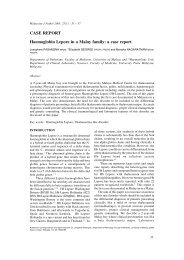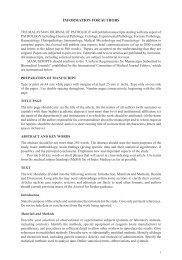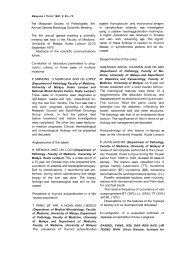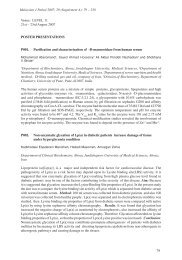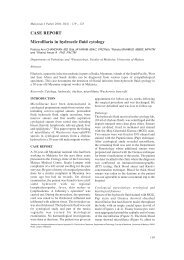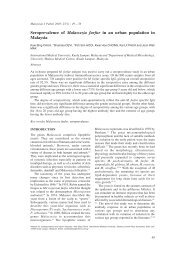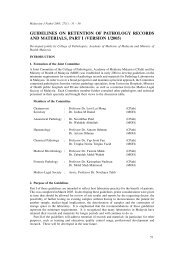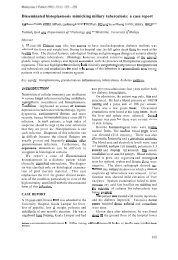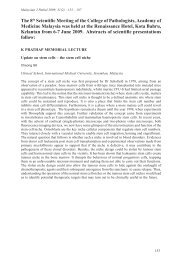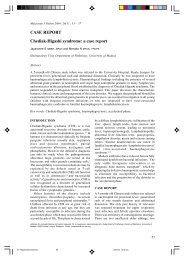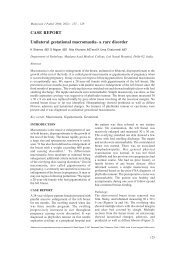Effect of pyridostigmine (Mestinon) on human platelet ... - MJPath
Effect of pyridostigmine (Mestinon) on human platelet ... - MJPath
Effect of pyridostigmine (Mestinon) on human platelet ... - MJPath
You also want an ePaper? Increase the reach of your titles
YUMPU automatically turns print PDFs into web optimized ePapers that Google loves.
Malaysian J Pathol 2009; 31(1) : 45 – 52<br />
ORIGINAL ARTICLE<br />
<str<strong>on</strong>g>Effect</str<strong>on</strong>g> <str<strong>on</strong>g>of</str<strong>on</strong>g> <str<strong>on</strong>g>pyridostigmine</str<strong>on</strong>g> (<str<strong>on</strong>g>Mestin<strong>on</strong></str<strong>on</strong>g>) <strong>on</strong> <strong>human</strong> <strong>platelet</strong><br />
aggregati<strong>on</strong><br />
C-F LEONG* FRCPE, FRCPA, M AINI-ARDENA* BSc, S-K CHEONG** FRCPE, FRCPA, and N NORRIS*<br />
MBBS, MPath.<br />
*Department <str<strong>on</strong>g>of</str<strong>on</strong>g> Pathology, Universiti Kebangsaan Malaysia Medical Centre, and<br />
** Department <str<strong>on</strong>g>of</str<strong>on</strong>g> Internal Medicine, Internati<strong>on</strong>al Medical University, Kuala Lumpur, Malaysia.<br />
Abstract<br />
Introducti<strong>on</strong>: Normal <strong>platelet</strong> functi<strong>on</strong>s are critical for achieving primary haemostasis. Numerous<br />
medicati<strong>on</strong>s have been shown to affect <strong>platelet</strong> functi<strong>on</strong>s. Pyridostigmine (<str<strong>on</strong>g>Mestin<strong>on</strong></str<strong>on</strong>g>), an orally active<br />
cholinesterase inhibitor that is comm<strong>on</strong>ly used to treat myasthenia gravis has been documented to<br />
cause epistaxis and prol<strong>on</strong>ged bleeding after a cut in anectodal reports. This study was initiated<br />
after a patient diagnosed to have myasthenia gravis, developed multiple bruises a week after being<br />
started <strong>on</strong> <str<strong>on</strong>g>Mestin<strong>on</strong></str<strong>on</strong>g>. The objective <str<strong>on</strong>g>of</str<strong>on</strong>g> this study was to investigate the effect <str<strong>on</strong>g>of</str<strong>on</strong>g> <str<strong>on</strong>g>Mestin<strong>on</strong></str<strong>on</strong>g> <strong>on</strong> <strong>platelet</strong><br />
aggregati<strong>on</strong> stimulated with various ag<strong>on</strong>ists in vitro. Materials and Methods:A stock soluti<strong>on</strong> <str<strong>on</strong>g>of</str<strong>on</strong>g><br />
<str<strong>on</strong>g>Mestin<strong>on</strong></str<strong>on</strong>g> was prepared by dissolving <str<strong>on</strong>g>Mestin<strong>on</strong></str<strong>on</strong>g> tablet in normal saline. A serial diluti<strong>on</strong> <str<strong>on</strong>g>of</str<strong>on</strong>g> <str<strong>on</strong>g>Mestin<strong>on</strong></str<strong>on</strong>g><br />
soluti<strong>on</strong>s was then prepared from this stock soluti<strong>on</strong>. Fresh whole blood from a normal healthy<br />
individual was added to this series <str<strong>on</strong>g>of</str<strong>on</strong>g> diluted <str<strong>on</strong>g>Mestin<strong>on</strong></str<strong>on</strong>g> soluti<strong>on</strong>s. These samples were then tested<br />
for <strong>platelet</strong> aggregati<strong>on</strong> using Chr<strong>on</strong>o-log <strong>platelet</strong> impedance aggregometer with various <strong>platelet</strong><br />
ag<strong>on</strong>ists. <str<strong>on</strong>g>Mestin<strong>on</strong></str<strong>on</strong>g>-free whole blood sample was used for c<strong>on</strong>trol. The patient’s whole blood sample<br />
taken at the time <str<strong>on</strong>g>of</str<strong>on</strong>g> bruises was also tested for <strong>platelet</strong> aggregati<strong>on</strong> using the same method. Results:<br />
The results showed that in the presence <str<strong>on</strong>g>of</str<strong>on</strong>g> <str<strong>on</strong>g>pyridostigmine</str<strong>on</strong>g> (<str<strong>on</strong>g>Mestin<strong>on</strong></str<strong>on</strong>g>), <strong>platelet</strong> aggregati<strong>on</strong> was<br />
inhibited in resp<strong>on</strong>se to ADP and collagen stimulati<strong>on</strong>s. However, when ag<strong>on</strong>ists such as ristocetin<br />
and arachid<strong>on</strong>ic acid were used, aggregati<strong>on</strong> <str<strong>on</strong>g>of</str<strong>on</strong>g> <strong>platelet</strong>s was detectable even though the degree <str<strong>on</strong>g>of</str<strong>on</strong>g><br />
aggregati<strong>on</strong> was relatively reduced when compared with c<strong>on</strong>trol samples. This pattern <str<strong>on</strong>g>of</str<strong>on</strong>g> anti-<strong>platelet</strong><br />
aggregati<strong>on</strong> was also seen in the patient sample. C<strong>on</strong>clusi<strong>on</strong>: Pyridostigmine interferes with <strong>human</strong><br />
<strong>platelet</strong> aggregati<strong>on</strong> and uncomm<strong>on</strong>ly in susceptible patient may result in bleeding tendency. Thus,<br />
healthcare workers need to be aware <str<strong>on</strong>g>of</str<strong>on</strong>g> this uncomm<strong>on</strong> side effect <str<strong>on</strong>g>of</str<strong>on</strong>g> <str<strong>on</strong>g>pyridostigmine</str<strong>on</strong>g>.<br />
Keywords: <str<strong>on</strong>g>pyridostigmine</str<strong>on</strong>g>, myasthenia gravis, anti-<strong>platelet</strong> aggregati<strong>on</strong>, <strong>platelet</strong> functi<strong>on</strong> study.<br />
INTRODUCTION<br />
Platelets are small, n<strong>on</strong>-nucleated blood cells<br />
formed in the b<strong>on</strong>e marrow. Normal <strong>platelet</strong><br />
functi<strong>on</strong>s, including <strong>platelet</strong> adhesi<strong>on</strong> and<br />
aggregati<strong>on</strong>, are critical for achieving primary<br />
haemostasis. When a blood vessel is injured,<br />
<strong>platelet</strong>s will adhere rapidly to the injured site<br />
and become activated. This is followed by the<br />
initiati<strong>on</strong> <str<strong>on</strong>g>of</str<strong>on</strong>g> prostaglandin synthesis and granule<br />
secreti<strong>on</strong> c<strong>on</strong>taining serot<strong>on</strong>in, adenosine<br />
diphosphate (ADP) and adenosine triphosphate<br />
(ATP). The release reacti<strong>on</strong> will stimulate<br />
aggregati<strong>on</strong> further and initiate coagulati<strong>on</strong><br />
cascade leading to fibrin depositi<strong>on</strong>, a process<br />
comm<strong>on</strong>ly known as sec<strong>on</strong>dary haemostasis. 1<br />
Disorders in <strong>platelet</strong>s may result in excessive<br />
bleeding when <strong>platelet</strong> level is low or increase<br />
the risk <str<strong>on</strong>g>of</str<strong>on</strong>g> thrombosis when the level is high.<br />
These disorders can be classified into two,<br />
namely primary (inherited) disorders or sec<strong>on</strong>dary<br />
(acquired) disorders. Inherited disorders are<br />
far less comm<strong>on</strong> than acquired disorders. For<br />
example, v<strong>on</strong> Willebrand disease is an inherited<br />
<strong>platelet</strong> disorder, characterized by the deficiency<br />
<str<strong>on</strong>g>of</str<strong>on</strong>g> v<strong>on</strong> Willebrand factor, a blood glycoprotein<br />
that is required for <strong>platelet</strong> adhesi<strong>on</strong>. 2<br />
Acquired disorders are usually brought <strong>on</strong> by<br />
underlying medical c<strong>on</strong>diti<strong>on</strong>s or through the<br />
c<strong>on</strong>sumpti<strong>on</strong> <str<strong>on</strong>g>of</str<strong>on</strong>g> certain medicati<strong>on</strong>s. Numerous<br />
medicati<strong>on</strong>s have been shown to affect <strong>platelet</strong><br />
Address for corresp<strong>on</strong>dence and reprint requests: Associate Pr<str<strong>on</strong>g>of</str<strong>on</strong>g>essor Le<strong>on</strong>g Chooi-Fun, Department <str<strong>on</strong>g>of</str<strong>on</strong>g> Pathology, Universiti Kebangsaan Medical<br />
Centre, Jalan Yaacob Latif, Bandar Tun Razak, Cheras, 56000 Kuala Lumpur, Malaysia. Tel: 03-91455842. Fax: 03-91738245. Email address: cfle<strong>on</strong>g@<br />
ppukm.ukm.my.<br />
45
Malaysian J Pathol June 2009<br />
functi<strong>on</strong>s. The list <str<strong>on</strong>g>of</str<strong>on</strong>g> drugs implicated is l<strong>on</strong>g<br />
but by no means exhaustive. Table 1 shows some<br />
comm<strong>on</strong> substances that have been shown to<br />
inhibit <strong>platelet</strong> activities. In additi<strong>on</strong>, there may<br />
be other drugs that do interfere with <strong>platelet</strong><br />
functi<strong>on</strong>s but their acti<strong>on</strong> remains undocumented.<br />
This study was initiated when a patient,<br />
diagnosed to have myasthenia gravis and started<br />
<strong>on</strong> <str<strong>on</strong>g>pyridostigmine</str<strong>on</strong>g>, developed multiple bruises<br />
a week into therapy. Preliminary investigati<strong>on</strong>s<br />
showed normal <strong>platelet</strong> count and coagulati<strong>on</strong><br />
screen. Platelet aggregati<strong>on</strong> study revealed an<br />
abnormal pr<str<strong>on</strong>g>of</str<strong>on</strong>g>ile <str<strong>on</strong>g>of</str<strong>on</strong>g> aggregati<strong>on</strong>. We acquired<br />
her medicati<strong>on</strong> from the hospital pharmacy and<br />
carried out the following experiments.<br />
MATERIALs and Methods<br />
Materials<br />
Pyridostigmine tablets (60 mg) [Valeant, IDS<br />
Services, Malaysia] were obtained from the<br />
Pharmacy Department, Hospital UKM. The<br />
<strong>platelet</strong> aggregati<strong>on</strong> reagents such as collagen,<br />
ADP, arachid<strong>on</strong>ic acid, ristocetin as well as the<br />
Chr<strong>on</strong>o-log Aggregometer Model 590D were<br />
purchased from Chr<strong>on</strong>o-log Corporati<strong>on</strong>, USA.<br />
Plastic tube c<strong>on</strong>taining 3.8% trisodium acetate<br />
was from Bect<strong>on</strong> Dickins<strong>on</strong> (BD), USA. Fresh<br />
whole blood sample was collected from a<br />
normal, healthy adult volunteer who was not <strong>on</strong><br />
any medicati<strong>on</strong> known to interfere with <strong>platelet</strong><br />
functi<strong>on</strong>s.<br />
TABLE 1: Drugs that affect <strong>platelet</strong> functi<strong>on</strong>*<br />
N<strong>on</strong>steroidal anti-inflammatory<br />
drugs (NSAIDs)<br />
• Aspirin<br />
• Ibupr<str<strong>on</strong>g>of</str<strong>on</strong>g>en<br />
• Mefenamic acid<br />
• Indomethacin<br />
• Cox-2 inhibitors<br />
Antimicrobials<br />
• Penicillins<br />
• Cephalosporin<br />
• Nitr<str<strong>on</strong>g>of</str<strong>on</strong>g>urantoin<br />
• Hydroxychloroquine<br />
• Amphotericin<br />
Cardiovascular agents<br />
• Β-adrenergic blockers (i.e. Propanol)<br />
• Vasodilators (i.e. nitroprusside,<br />
nitroglycerin)<br />
• Diuretics (i.e. furosemide)<br />
• Calcium channel blockers<br />
Psychotropics and anesthetics<br />
• Tricyclic antidepressants (i.e. imipramine)<br />
• Phenothiazines (i.e. chlorpromazine)<br />
• Local and general anesthesia (i.e. halothane)<br />
Chemotherapeutic agents<br />
• Mithramycin<br />
• Daunorubicin<br />
• Carmustine<br />
Miscellaneous agents<br />
• Dextrans<br />
• Radiographic c<strong>on</strong>trast<br />
• Quinidine<br />
• Ethanol<br />
Foods<br />
• Caffeine<br />
• Garlic<br />
• Cumin<br />
• Tumeric<br />
Anticoagulants<br />
• Heparin<br />
• Coumarin<br />
• Lepirudin<br />
• Argatroban<br />
• Bivalirudin<br />
Thrombolytic agents<br />
• Streptokinase<br />
• Urokinase<br />
• Tissue Plasminogen activators<br />
46<br />
Anti<strong>platelet</strong> drugs<br />
• Phosphodiesterase inhibitors<br />
• Dipyridamole<br />
• Cilostazole<br />
* Adapted from George JN, Shattil SJ. N Engl J Med 1991; 324:27-39.<br />
Adenosine diphosphate receptor antag<strong>on</strong>ists<br />
• Ticlopidine<br />
• Clopidogrel<br />
Glycoprotein IIb/IIIa antag<strong>on</strong>ists<br />
• Abciximab<br />
• Epifibatide<br />
• Tir<str<strong>on</strong>g>of</str<strong>on</strong>g>iban
PYRIDOSTIGMINE AND PLATELET AGGREGATION<br />
Preparati<strong>on</strong> <str<strong>on</strong>g>of</str<strong>on</strong>g> stock and diluted <str<strong>on</strong>g>pyridostigmine</str<strong>on</strong>g><br />
soluti<strong>on</strong>s<br />
Two <str<strong>on</strong>g>pyridostigmine</str<strong>on</strong>g> tablets (60 mg) were first<br />
dissolved in 24 mL <str<strong>on</strong>g>of</str<strong>on</strong>g> normal saline and the<br />
mixture was centrifuged at 1500 rpm for 15<br />
minutes. The supernatant <str<strong>on</strong>g>of</str<strong>on</strong>g> <str<strong>on</strong>g>pyridostigmine</str<strong>on</strong>g><br />
soluti<strong>on</strong> (5 mg/mL) was then separated out from<br />
the pellet <str<strong>on</strong>g>of</str<strong>on</strong>g> the unwanted debris. A series <str<strong>on</strong>g>of</str<strong>on</strong>g><br />
diluted <str<strong>on</strong>g>pyridostigmine</str<strong>on</strong>g> soluti<strong>on</strong>s (i.e. 1:2, 1:4,<br />
1:8, 1:16, 1:32, 1:64 and 1:128) was prepared<br />
from the stock soluti<strong>on</strong> by double diluti<strong>on</strong>s using<br />
normal saline. 4 mL <str<strong>on</strong>g>of</str<strong>on</strong>g> the stock soluti<strong>on</strong> (1:1)<br />
was removed and diluted with 4 mL <str<strong>on</strong>g>of</str<strong>on</strong>g> normal<br />
saline to give rise to a 1:2 diluti<strong>on</strong>. From the 1:2<br />
diluti<strong>on</strong>, 4 mL was again removed and diluted<br />
with another 4 mL <str<strong>on</strong>g>of</str<strong>on</strong>g> normal saline to give rise<br />
to a 1:4 diluti<strong>on</strong>. The same steps were repeated<br />
for the subsequent diluti<strong>on</strong>s until the final 1:128<br />
diluti<strong>on</strong>. In this way, the final c<strong>on</strong>centrati<strong>on</strong>s<br />
<str<strong>on</strong>g>of</str<strong>on</strong>g> <str<strong>on</strong>g>Mestin<strong>on</strong></str<strong>on</strong>g> soluti<strong>on</strong>s after additi<strong>on</strong> <str<strong>on</strong>g>of</str<strong>on</strong>g> equal<br />
volume <str<strong>on</strong>g>of</str<strong>on</strong>g> test sample reflect the range <str<strong>on</strong>g>of</str<strong>on</strong>g> serum<br />
c<strong>on</strong>centrati<strong>on</strong>s <str<strong>on</strong>g>of</str<strong>on</strong>g> <str<strong>on</strong>g>Mestin<strong>on</strong></str<strong>on</strong>g> in a patient taking<br />
therapeutic doses <str<strong>on</strong>g>of</str<strong>on</strong>g> <str<strong>on</strong>g>Mestin<strong>on</strong></str<strong>on</strong>g>.<br />
Preparati<strong>on</strong> <str<strong>on</strong>g>of</str<strong>on</strong>g> test samples.<br />
50 mL <str<strong>on</strong>g>of</str<strong>on</strong>g> fresh whole blood from volunteer was<br />
collected into sterile plastic tubes c<strong>on</strong>taining 3.8%<br />
trisodium acetate as the anticoagulant. Equivalent<br />
amount <str<strong>on</strong>g>of</str<strong>on</strong>g> the fresh whole blood was then added<br />
to the series <str<strong>on</strong>g>of</str<strong>on</strong>g> diluted <str<strong>on</strong>g>pyridostigmine</str<strong>on</strong>g> soluti<strong>on</strong><br />
(i.e 4 mL <str<strong>on</strong>g>of</str<strong>on</strong>g> whole blood in 4 mL <str<strong>on</strong>g>of</str<strong>on</strong>g> diluted<br />
<str<strong>on</strong>g>pyridostigmine</str<strong>on</strong>g> soluti<strong>on</strong>). A <str<strong>on</strong>g>pyridostigmine</str<strong>on</strong>g>-free<br />
fresh whole blood was used as a c<strong>on</strong>trol. An<br />
EDTA sample was also sent for full blood count<br />
to determine the <strong>platelet</strong> count.<br />
Platelet aggregati<strong>on</strong> test.<br />
The <strong>platelet</strong> aggregati<strong>on</strong> test was c<strong>on</strong>ducted by<br />
impedance aggregometry using the whole blood<br />
Chr<strong>on</strong>o-log Aggregometer Model 590D. Each <str<strong>on</strong>g>of</str<strong>on</strong>g><br />
the test samples (including c<strong>on</strong>trol) was tested<br />
for their <strong>platelet</strong> aggregati<strong>on</strong> in resp<strong>on</strong>se to the<br />
following ag<strong>on</strong>ists: ADP (5 μM and 10 μM),<br />
collagen (2 μg/mL and 5 μg/mL), arachid<strong>on</strong>ic<br />
acid (0.5 mM) and ristocetin (1.0 mg/mL).<br />
RESULTS<br />
The volunteer selected for this study was found<br />
to be healthy and showed no sign <str<strong>on</strong>g>of</str<strong>on</strong>g> bleeding<br />
tendency. Platelet count from the normal<br />
volunteer was 200 x 10 9 /L, which was within<br />
the reference range <str<strong>on</strong>g>of</str<strong>on</strong>g> <strong>platelet</strong> count <str<strong>on</strong>g>of</str<strong>on</strong>g> 150-400<br />
x 10 9 /L. The <strong>platelet</strong> aggregati<strong>on</strong> study showed<br />
that in the absence <str<strong>on</strong>g>of</str<strong>on</strong>g> <str<strong>on</strong>g>pyridostigmine</str<strong>on</strong>g>, normal<br />
<strong>platelet</strong> aggregati<strong>on</strong> was detected up<strong>on</strong> additi<strong>on</strong><br />
<str<strong>on</strong>g>of</str<strong>on</strong>g> ADP, collagen, arachid<strong>on</strong>ic acid and ristocetin<br />
as shown in Table 2. The impedance values<br />
or <strong>platelet</strong> aggregati<strong>on</strong> <str<strong>on</strong>g>of</str<strong>on</strong>g> the c<strong>on</strong>trol samples<br />
were within the normal reference ranges <str<strong>on</strong>g>of</str<strong>on</strong>g> the<br />
respective ag<strong>on</strong>ists used.<br />
However, in the presence <str<strong>on</strong>g>of</str<strong>on</strong>g> <str<strong>on</strong>g>pyridostigmine</str<strong>on</strong>g>,<br />
no or negligible aggregati<strong>on</strong> was detected<br />
when ADP (5 μM and 10 μM) was added<br />
into the blood sample (Fig. 1). This inhibiti<strong>on</strong><br />
<str<strong>on</strong>g>of</str<strong>on</strong>g> aggregati<strong>on</strong> was observed in all different<br />
diluti<strong>on</strong>s <str<strong>on</strong>g>of</str<strong>on</strong>g> <str<strong>on</strong>g>pyridostigmine</str<strong>on</strong>g> even at 1:128. Results<br />
also showed no or negligible aggregati<strong>on</strong> in<br />
samples with higher levels <str<strong>on</strong>g>of</str<strong>on</strong>g> <str<strong>on</strong>g>pyridostigmine</str<strong>on</strong>g><br />
(1:1 and 1:2 diluti<strong>on</strong>s) with the additi<strong>on</strong> <str<strong>on</strong>g>of</str<strong>on</strong>g> 2<br />
μg/mL <str<strong>on</strong>g>of</str<strong>on</strong>g> collagen as shown in Fig. 2 (A & B).<br />
TABLE 2: <str<strong>on</strong>g>Effect</str<strong>on</strong>g> <str<strong>on</strong>g>of</str<strong>on</strong>g> different diluti<strong>on</strong> <str<strong>on</strong>g>of</str<strong>on</strong>g> <str<strong>on</strong>g>pyridostigmine</str<strong>on</strong>g> <strong>on</strong> normal <strong>platelet</strong> aggregati<strong>on</strong><br />
(measured in ohms) when tested against different ag<strong>on</strong>ists.<br />
Reference<br />
Ag<strong>on</strong>ist used range Final diluti<strong>on</strong> <str<strong>on</strong>g>of</str<strong>on</strong>g> <str<strong>on</strong>g>pyridostigmine</str<strong>on</strong>g> added to the<br />
(ohm)<br />
normal blood sample (1/n)<br />
C<strong>on</strong>trol 1 2 4 8 16 32 64 128<br />
ADP 5 μM 1-17 8 0 0 0 1 1 2 1 0<br />
ADP 10 μM 6-24 14 0 0 0 1 0 0 0 1<br />
Collagen 2 μg/mL 15-27 21 0 0 16 14 14 12 18 16<br />
Collagen 5 μg/mL 15-31 30 12 15 18 18 17 15 20 20<br />
Arachid<strong>on</strong>ic Acid 0.5 mM 5-17 20 2 8 16 13 10 10 13 11<br />
Ristocetin 1.0 mg/mL >5 16 6 4 12 6 11 10 9 7<br />
NB: C<strong>on</strong>trol samples do not c<strong>on</strong>tain any <str<strong>on</strong>g>pyridostigmine</str<strong>on</strong>g>.<br />
47
Malaysian J Pathol June 2009<br />
(A)<br />
(B)<br />
(C)<br />
(D)<br />
(E)<br />
FIG. 1: Impedance aggregometry pattern for the different diluti<strong>on</strong>s <str<strong>on</strong>g>of</str<strong>on</strong>g> <str<strong>on</strong>g>pyridostigmine</str<strong>on</strong>g>-c<strong>on</strong>taining whole blood<br />
sample in resp<strong>on</strong>se to 5 μM <str<strong>on</strong>g>of</str<strong>on</strong>g> ADP (A – D). (E) is the impedance aggregometry pattern <str<strong>on</strong>g>of</str<strong>on</strong>g> <str<strong>on</strong>g>pyridostigmine</str<strong>on</strong>g>free<br />
c<strong>on</strong>trol sample.<br />
48
PYRIDOSTIGMINE AND PLATELET AGGREGATION<br />
(A)<br />
(B)<br />
(C)<br />
(D)<br />
(E)<br />
FIG. 2: Impedance aggregometry pattern for different diluti<strong>on</strong>s <str<strong>on</strong>g>of</str<strong>on</strong>g> <str<strong>on</strong>g>pyridostigmine</str<strong>on</strong>g>-c<strong>on</strong>taining whole blood samples<br />
in resp<strong>on</strong>se to collagen 2 μg/mL (A,B) and 5 μg/mL (C,D). (E) is the impedance aggregometry pattern<br />
<str<strong>on</strong>g>of</str<strong>on</strong>g> <str<strong>on</strong>g>pyridostigmine</str<strong>on</strong>g>-free c<strong>on</strong>trol sample.<br />
49
Malaysian J Pathol June 2009<br />
(A) (B) (C)<br />
(D)<br />
(E)<br />
(F)<br />
(G) (H) (I)<br />
FIG. 3: Impedance aggregometry pattern for the different diluti<strong>on</strong>s <str<strong>on</strong>g>of</str<strong>on</strong>g> <str<strong>on</strong>g>pyridostigmine</str<strong>on</strong>g>-c<strong>on</strong>taining whole blood<br />
samples in resp<strong>on</strong>se to arachid<strong>on</strong>ic acid 0.5 mM (A-D) and to ristocetin 1.0 mg/mL (E-H). (I) is the<br />
impedance aggregometry pattern <str<strong>on</strong>g>of</str<strong>on</strong>g> <str<strong>on</strong>g>pyridostigmine</str<strong>on</strong>g>-free c<strong>on</strong>trol sample.<br />
While at lower levels <str<strong>on</strong>g>of</str<strong>on</strong>g> <str<strong>on</strong>g>pyridostigmine</str<strong>on</strong>g> (≥1:4<br />
diluti<strong>on</strong>s) , <strong>platelet</strong> aggregati<strong>on</strong> was detected<br />
with the additi<strong>on</strong> <str<strong>on</strong>g>of</str<strong>on</strong>g> collagen but at a slightly<br />
lower aggregati<strong>on</strong> level when compared with<br />
the c<strong>on</strong>trol.<br />
In c<strong>on</strong>trast, <strong>platelet</strong> aggregati<strong>on</strong> was detected<br />
when collagen at 5 μg/mL (Fig. 2 C & D),<br />
arachid<strong>on</strong>ic acid 0.5mM (Fig. 3 A-D) and<br />
ristocetin 1.0mg/mL (Fig. 3 E-H) were used<br />
as ag<strong>on</strong>ists <strong>on</strong> the samples in the presence<br />
<str<strong>on</strong>g>of</str<strong>on</strong>g> <str<strong>on</strong>g>pyridostigmine</str<strong>on</strong>g>. However, the degrees<br />
<str<strong>on</strong>g>of</str<strong>on</strong>g> aggregati<strong>on</strong> were comparatively lower<br />
when compared to c<strong>on</strong>trol samples for all the<br />
ag<strong>on</strong>ists.<br />
50
PYRIDOSTIGMINE AND PLATELET AGGREGATION<br />
FIG. 4: Impedance aggregometry pattern <str<strong>on</strong>g>of</str<strong>on</strong>g> the patient’s whole blood sample in resp<strong>on</strong>se to 5 μM ADP and<br />
2 μg/mL <str<strong>on</strong>g>of</str<strong>on</strong>g> collagen.<br />
DISCUSSION<br />
Platelet aggregati<strong>on</strong> test is an established<br />
method used to assess <strong>platelet</strong> functi<strong>on</strong>. Our<br />
Haemostasis Laboratory uses an aggregometer<br />
to evaluate <strong>platelet</strong> functi<strong>on</strong>s by measuring the<br />
electrical impedance caused by the aggregating<br />
<strong>platelet</strong>s in whole blood sample. The increase<br />
in the electrical resistance (measured in ohms)<br />
is directly proporti<strong>on</strong>al to the mass <str<strong>on</strong>g>of</str<strong>on</strong>g> the<br />
aggregated <strong>platelet</strong>s. 3<br />
Platelet aggregati<strong>on</strong> study in the laboratory<br />
is an effort to assess the in vivo ability <str<strong>on</strong>g>of</str<strong>on</strong>g> the<br />
<strong>platelet</strong>s to form the primary haemostatic plug.<br />
Platelets are found to aggregate in the presence <str<strong>on</strong>g>of</str<strong>on</strong>g><br />
a number <str<strong>on</strong>g>of</str<strong>on</strong>g> different aggregating agents and the<br />
aggregati<strong>on</strong> varies with different agents and with<br />
their c<strong>on</strong>centrati<strong>on</strong>s. Am<strong>on</strong>g comm<strong>on</strong>ly used<br />
aggregating agents are ADP, collagen, ristocetin<br />
and arachid<strong>on</strong>ic acid. The ability or inability <str<strong>on</strong>g>of</str<strong>on</strong>g><br />
<strong>platelet</strong>s to resp<strong>on</strong>d to a particular aggregating<br />
agent c<strong>on</strong>stitutes the basis for differentiating the<br />
types <str<strong>on</strong>g>of</str<strong>on</strong>g> <strong>platelet</strong> dysfuncti<strong>on</strong>s. In terms <str<strong>on</strong>g>of</str<strong>on</strong>g> <strong>platelet</strong><br />
dysfuncti<strong>on</strong>, acquired disorders are more frequent<br />
than inherited disorders and the most frequent<br />
cause <str<strong>on</strong>g>of</str<strong>on</strong>g> acquired disorders is the ingesti<strong>on</strong> <str<strong>on</strong>g>of</str<strong>on</strong>g><br />
drugs with anti-<strong>platelet</strong> activity. 4,5,6<br />
However, many drugs may have anti-<strong>platelet</strong><br />
effect but their acti<strong>on</strong>s were not documented, as<br />
they usually do not cause any significant clinical<br />
bleeding. Pyridostigmine bromide is an orally<br />
active cholinesterase inhibitor comm<strong>on</strong>ly used<br />
to treat myasthenia gravis. Bleeding tendency<br />
is a rare side effect <str<strong>on</strong>g>of</str<strong>on</strong>g> the drug. Documented<br />
manifestati<strong>on</strong>s include epitaxis and prol<strong>on</strong>ged<br />
bleeding after a cut. This side effect is not<br />
normally included in the drug insert. The patient<br />
who prompted this study developed multiple<br />
bruises a week after starting treatment for<br />
myasthenia gravis. Full blood count was within<br />
normal limits with adequate <strong>platelet</strong> count. An<br />
abnormal <strong>platelet</strong> aggregati<strong>on</strong> pr<str<strong>on</strong>g>of</str<strong>on</strong>g>ile (Figure 4)<br />
was dem<strong>on</strong>strated from the whole blood sample<br />
even though the patient was <str<strong>on</strong>g>of</str<strong>on</strong>g>f <str<strong>on</strong>g>pyridostigmine</str<strong>on</strong>g><br />
for about four days. As the patient had no family<br />
history <str<strong>on</strong>g>of</str<strong>on</strong>g> bleeding disorder and was not <strong>on</strong><br />
any other medicati<strong>on</strong>, we hypothesized that the<br />
observed abnormalities in her <strong>platelet</strong> functi<strong>on</strong>s<br />
were due to the drug <str<strong>on</strong>g>pyridostigmine</str<strong>on</strong>g>. The present<br />
study carried out with <str<strong>on</strong>g>pyridostigmine</str<strong>on</strong>g> <strong>on</strong> d<strong>on</strong>or’s<br />
<strong>platelet</strong> c<strong>on</strong>firms this hypothesis.<br />
It is postulated that <str<strong>on</strong>g>pyridostigmine</str<strong>on</strong>g> affects<br />
<strong>platelet</strong> aggregati<strong>on</strong> by inhibiting or interfering<br />
with the binding <str<strong>on</strong>g>of</str<strong>on</strong>g> ADP to its membrane<br />
receptors. ADP binds to a specific membrane<br />
receptor, which is associated with the GPIIb/<br />
GPIIIa complex <strong>on</strong> the <strong>platelet</strong> membrane<br />
and also with calcium i<strong>on</strong>s redistributi<strong>on</strong> in<br />
the cytoplasm. Binding <str<strong>on</strong>g>of</str<strong>on</strong>g> ADP activates the<br />
membrane complex leading to shape changes in<br />
the <strong>platelet</strong>s, release reacti<strong>on</strong> and further <strong>platelet</strong><br />
adhesi<strong>on</strong>, activati<strong>on</strong> and aggregati<strong>on</strong>. 7 The<br />
abnormalities appeared to be due to defects in the<br />
<strong>platelet</strong> activati<strong>on</strong> pathway after stimulati<strong>on</strong> by<br />
ADP in the presence <str<strong>on</strong>g>of</str<strong>on</strong>g> <str<strong>on</strong>g>pyridostigmine</str<strong>on</strong>g>. However,<br />
the exact mechanism by which Pyridostigmine<br />
acts and its minimum inhibitory c<strong>on</strong>centrati<strong>on</strong><br />
<strong>on</strong> <strong>platelet</strong> aggregati<strong>on</strong> was bey<strong>on</strong>d the scope<br />
<str<strong>on</strong>g>of</str<strong>on</strong>g> this study.<br />
In c<strong>on</strong>clusi<strong>on</strong>, the results from this study<br />
show that <strong>platelet</strong> aggregati<strong>on</strong> in the whole blood<br />
51
Malaysian J Pathol June 2009<br />
samples c<strong>on</strong>taining <str<strong>on</strong>g>pyridostigmine</str<strong>on</strong>g> appeared<br />
to be relatively lower than that <str<strong>on</strong>g>of</str<strong>on</strong>g> the c<strong>on</strong>trol<br />
for all <str<strong>on</strong>g>of</str<strong>on</strong>g> the ag<strong>on</strong>ists used. This effect was<br />
most marked in resp<strong>on</strong>se to the ag<strong>on</strong>ist ADP<br />
and these findings could have explained the<br />
multiple bruises experienced by our patient.<br />
Thus, healthcare workers should be aware <str<strong>on</strong>g>of</str<strong>on</strong>g><br />
this potential side effect <str<strong>on</strong>g>of</str<strong>on</strong>g> Pyridostigmine in<br />
susceptible individual.<br />
ACKNOWLEDGEMENTS<br />
We would like to acknowledge the secretarial<br />
help <str<strong>on</strong>g>of</str<strong>on</strong>g> Ms Ho<strong>on</strong>-Ko<strong>on</strong> Teoh in preparing this<br />
manuscript for publicati<strong>on</strong>.<br />
REFERENCES<br />
1. Hutt<strong>on</strong> RA, Laffan MA, Tuddenham EGD. Normal<br />
haemostasis. In: H<str<strong>on</strong>g>of</str<strong>on</strong>g>fband AV, Lewis SM, Tuddenham<br />
EGD, eds. Postgraduate Haematology 4 th Ed.<br />
Butterworth Heinemann. 1999; 550-580.<br />
2. Sadler JE. Biochemistry and Genetics <str<strong>on</strong>g>of</str<strong>on</strong>g> v<strong>on</strong> Willebrand<br />
factor. Annu Rev Biochem 1998; 67:395-424.<br />
3. Cardinal DC, Flower RJ. The electric aggregometer.<br />
A novel device for assessing <strong>platelet</strong> behaviour in<br />
blood. J Pharmacol Meth. 1980; 3(135): 158.<br />
4. Cliveden PB, Salzman EW. Platelet metabolism and<br />
the effects <str<strong>on</strong>g>of</str<strong>on</strong>g> drugs, In: Walter Bowie EJ and Sharp<br />
AA, eds. Hemostasis and Thrombosis. Butterworths.<br />
1985;1-35.<br />
5. Entwistle MBP, Williams CE, Short PE. Evaluati<strong>on</strong><br />
<str<strong>on</strong>g>of</str<strong>on</strong>g> <strong>platelet</strong> functi<strong>on</strong>. In Williams: CE, Short PE,<br />
George AJ and Entwistle MBP, eds. Critical Factors<br />
in Haemostasis – Evaluati<strong>on</strong> and Development. Ellis<br />
Harwood Ltd and VCH. 1988; 67-103.<br />
6. Rodgers GM. Overview <str<strong>on</strong>g>of</str<strong>on</strong>g> <strong>platelet</strong> physiology and<br />
laboratory evaluati<strong>on</strong> <str<strong>on</strong>g>of</str<strong>on</strong>g> <strong>platelet</strong> functi<strong>on</strong>. Clin<br />
Obstet Gynecol. 1999; 42(2): 349-59<br />
7. Savage B, Cattaneo M, Ruggeri ZM. Mechanisms<br />
<str<strong>on</strong>g>of</str<strong>on</strong>g> <strong>platelet</strong> aggregati<strong>on</strong>. Curr Opin Hematol.<br />
2001;8(5):270-6.<br />
52




